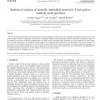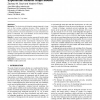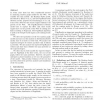RSA
2010
14 years 3 days ago
2010
We show that asymptotic equivalence, in a strong form, holds between two random graph models with slightly differing edge probabilities under substantially weaker conditions than w...
IJON
2007
14 years 5 months ago
2007
Many conceptual studies of local cortical networks assume completely random wiring. For spatially extended networks, however, such random graph models are inadequate. The geometry...
BIOINFORMATICS
2007
14 years 5 months ago
2007
Motivation: The functioning of biological networks depends in large part on their complex underlying structure. When studying their systemic nature many modeling approaches focus ...
SODA
2008
ACM
14 years 6 months ago
2008
ACM
In recent years there has been considerable interest in analyzing random graph models for the Web. We consider two such models - the Random Surfer model, introduced by Blum et al....
WAW
2007
Springer
14 years 11 months ago
2007
Springer
Inspired by the recent interest in combining geometry with random graph models, we explore in this paper two generalizations of the random dot product graph model proposed by Kraet...
DCC
2001
IEEE
15 years 5 months ago
2001
IEEE
We consider the problem of compressing graphs of the link structure of the World Wide Web. We provide efficient algorithms for such compression that are motivated by recently prop...
PODS
2006
ACM
15 years 5 months ago
2006
ACM
The link structure of the Web can be viewed as a massive graph. The preferential attachment model and its variants are well-known random graph models that help explain the evoluti...



